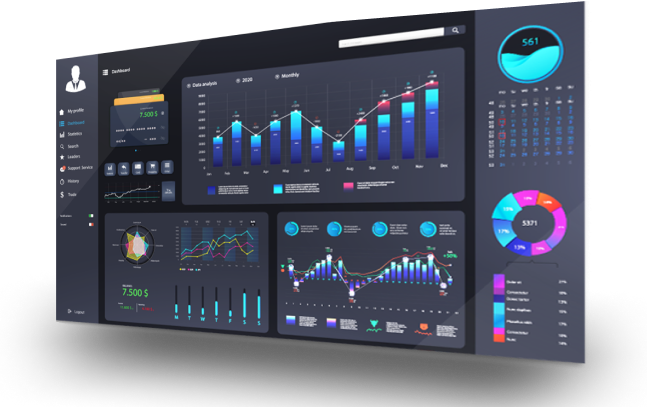Impressions
Common Abbreviation: Impr.
An “impression” represents each time your ad is shown, be it on a search result page, another web page within your platform’s ad network, or within a user’s social media feed.
Each time the ad is displayed, the serving of the ad is counted as one impression. Having this information can be useful in understanding how often your ad is served to users.
It’s important to note that just because the ad is displayed, this doesn’t mean that users actually saw your ad, which is why some advertising platforms offer additional, related metrics to help further understand your online visibility. The following are some examples of related metrics offered by Google Ads:
Viewable Impressions
Common Abbreviation: Viewable impr.
Google defines a “Viewable impr.” as the number of times an ad was viewable. An ad is viewable when at least 50% of its area is visible for 1 second for Display Network ads, or 2 seconds for video ads.
Non-viewable Impressions
Common Abbreviation: Non-viewable impr.
Google defines a “Non-viewable impr.” as the number of times your ad was considered non-viewable. An ad is non-viewable when it doesn’t have at least 50% of its area visible for at least 1 second for Display Network ads, or 2 seconds for video ads.
Measurable Impressions
Common Abbreviation: Measurable impr.
Google defines “Measurable impressions” as the number of times your ad appeared in locations on websites or apps that could be measured for viewability. Because only measurable impressions can be assessed for viewability, this can help you understand your ad’s viewable rate.
Non-measurable Impressions
Common Abbreviation: Non-measurable impr.
Google defines “Non-measurable impr.” as the number of times your ad appeared in locations that aren’t able to measure viewability.
Search Absolute Top Impression Rate
Common Abbreviation: Impr. (Abs. Top) %
Google defines “Search absolute top impression rate” as the percent of your impressions that are shown as the very first ad above the organic search results, and states that this metric can be used to see whether changes in performance are due to changes in your ads’ location.
Search Top Impression Rate
Common Abbreviation: Impr. (Top) %
Google defines “Search top impression rate” as the percent of your impressions that are shown anywhere above the organic search results, and states that this metrican can be used to see whether changes in performance are due to changes in your ads’ location.
Viewable Impression Distribution
Common Abbreviation: Viewable impr. distrib.
Google defines “Viewable impression distribution” as the percentage of your total ad impressions that were considered viewable. Total impressions include both measurable and non-measurable impressions. This differs from “viewable rate,” which only includes measurable impressions.
Non-viewable Impression Distribution
Common Abbreviation: Non-viewable impr. distrib.
Google defines “Non-viewable impression distribution” as the percentage of your total ad impressions that were considered non-viewable. Total impressions include both measurable and non-measurable impressions. This can help you understand how many of your ad’s impressions couldn’t be viewed.
Non-measurable Impression Distribution
Common Abbreviation: Non-measurable impr. distrib.
Google defines “Non-measurable impr. distrib.” as the percentage of your total impressions that appeared in locations that aren’t able to measure viewability.
Search Impression Share
Common Abbreviation: Search impr. share
Google defines “Search impression share” as the impressions you’ve received on the Search Network divided by the estimated number of impressions you were eligible to receive; whereas, eligibility is based on your current ads’ targeting settings, approval statuses, bids, and quality. Impression share data is updated daily.
Search Lost Impression Share (Rank)
Common Abbreviation: Search lost IS (rank)
Google defines “Search lost impression share (rank)” as the estimated percentage of how often your ad didn’t show on the Search Network due to poor Ad Rank. Ad Rank is a metric that determines your ad position and whether your ad is able to show at all, and is calculated using your bid, ad and website quality, context of the search, Ad Rank Thresholds, and the expected impact of extensions and other ad formats.
Search Lost Impression Share (Budget)
Common Abbreviation: Search lost IS (budget)
Google defines “Search lost impression share (budget)” as the estimated percentage of how often your ad didn’t show on the Search Network due to low budget.
Display Lost Impression Share (Rank)
Common Abbreviation: Display lost IS (rank)
Google defines “Display lost impression share (rank)” as the estimated percentage of impressions on the Google Display Network that your ads didn’t receive due to poor Ad Rank. Ad Rank determines your ad position and whether your ad is able to show at all, and is calculated using your bid, quality, and the expected impact of ad formats.
Display Lost Impression Share (Budget)
Common Abbreviation: Display lost IS (budget)
Google defines “Display Lost impression share (budget)” as the estimated percentage of how often your ad didn’t show on the Display Network due to low budget.
Common Impression-related Issues
Ads Not Serving Impressions
The most common issues impacting your ads’ abilities to serve impressions are as follows:
- Inappropriate or Restrictive Settings
In these scenarios, bids, budgets, targeting, and frequency capping settings can impact an ad’s ability to serve and/or the volume at which it serves.
- Ad Disapprovals (or Status Pending)
In these scenarios, the reason the ad is not serving impressions is because the ad itself is disapproved or has a pending status. For pending status issues, the ad is still in the review process by Google, and will begin serving upon the review being completed and the ad approved. For disapprovals, Google will typically provide an explanation for the disapproval, which can then be addressed as appropriate.
- Impression Share Lost to Budget
In these scenarios, the ad is not serving as often as it would otherwise be eligible because the associated budget is too low. Increasing the budget will reduce the amount of impression share lost to budget.
- Impression Share Lost to Rank
In these scenarios, the ad’s visibility is limited due to ad rank, which determines the ad’s position and whether it is served at all. Addressing this issue and effectively reducing the amount of impression share lost to rank often requires steps be taken to improve your quality score, bids, and/or usage of ad formats and extensions.
Impressions But No Clicks
Another common impression-related issue involves an ad serving impressions, but not acquiring clicks.
This is a function of the ad not having a sufficient click-though-rate (CTR), which measures the rate at which people click your ad. A similar metric that measures engagement with ads is interaction rate, which includes interactions like clicks, video views, calls, etc.
The ways to improve CTR (and Interaction Rate) involve optimizing the quality of the ad’s components, which include headlines, description lines, display URLs, path fields, image and/or video assets, extensions, etc.
Another way to address CTR may be to test ad positioning, as ads ranked in premium ad positions tend to have higher click engagement than ads not positioned as well.
JUMP TO A CATEGORY
WEB ANALYTICS | SEARCH OPTIMIZATION | PAID ADVERTISING | COMPANY NEWS










